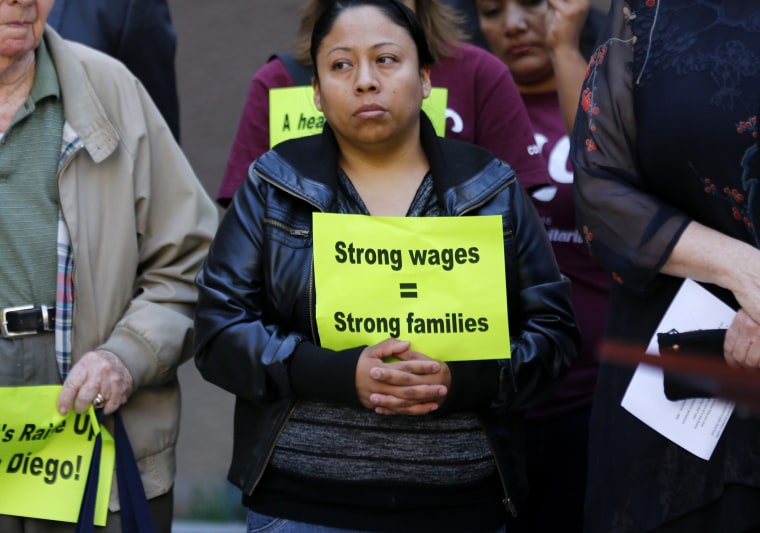In Washington, D.C., the harder President Obama pushes for an increase to the minimum wage, the harder congressional Republicans push back in the opposite direction. The likelihood of GOP lawmakers changing their mind, at least for now, is effectively zero.
An increase in the state's minimum wage to $9.50 an hour is nearly law, making Minnesota the latest state controlled by Democrats to offer the lowest wage workers a boost. The final House vote of 71-60 delivers the measure to DFL Gov. Mark Dayton, who says he will be happy to sign it into law, and brings to an end a multiyear debate among Democrats about the wage floor. President Obama celebrated the move. "I commend the state Legislature for raising their minimum wage and we look forward to Governor Dayton signing the bill into law soon," Obama said in a statement. "Congress should listen to the majority of Americans who say it's time to give America a raise and help ensure that no American who works full time has to raise a family in poverty."
The formal bill signing with Minnesota's Democratic governor is scheduled for Monday. The increase, which will be phased in over two years, doesn't go quite as far as the $10.10/hour wage national Democrats are seeking, but it will still be well above the current federal minimum of $7.25/hour.
Minnesota's move comes on the heels of
Maryland's decision to increase its minimum wage, which came on the heels of
Connecticut raising its minimum wage.
What's more, workers can expect more progress elsewhere very soon. In
Massachusetts, for example, the Democratic majority is trying to decide between a $10.50 and an $11 minimum wage. In
Hawaii, policymakers are nearly done with a proposal to raise their state's minimum wage to $10 an hour by 2018. In
Vermont, a plan is nearly in place for a more expedited implementation of a $10.10 minimum wage.
And if you're thinking all of these states have something in common, you're correct.
Connecticut, Maryland, Minnesota, Massachusetts, Hawaii, and Vermont all are reliable "blue" states, governed by Democratic legislatures working with Democratic governors. (In
Michigan, where there's a strong public demand for an increase, Republicans control the reigns of state government, so citizens are having to work around their elected officials to get the issue on the statewide ballot this November,)
All of this reminded me of
a report my colleague Will Femia passed along the other day about health care.
The Urban Institute's Health Reform Monitoring Survey (HRMS) has been tracking insurance coverage since the first quarter of 2013. Today, we report the first estimate of how the uninsurance rate has changed through early March 2014. These results track changes through most of the first Affordable Care Act's (ACA) open-enrollment period, which ended on March 31, 2014. Analysis of data from the March 2014 HRMS shows the uninsurance rate for nonelderly adults (age 18–64) was 15.2 percent for the nation, a drop of 2.7 percentage points since September 2013, the month before ACA open enrollment began. This represents a gain in coverage for about 5.4 million adults. States that implemented the ACA's Medicaid expansion saw a larger decline: their uninsurance rates for adults dropped 4.0 percentage points since September, compared with a drop of 1.5 percentage points for the nonexpanding states. The average uninsurance rate for adults in the 24 nonexpanding states was 18.1 percent in March 2014, well above the 12.4 percent average in the expansion states.
That last part was of particular interest. The overall trend is encouraging, but there's a sharp difference between progress in "blue" states that have embraced Medicaid expansion and "red" states that haven't.
The fact that the citizens of "red" and "blue" states live in what are essentially two countries with very different governments has largely flown under the radar, but it may become the defining story of our time. [...] This growing coverage gap isn't entirely a result of the Medicaid expansion -- the rate of uninsured dropped by four percentage points in expanding states and 1.5 points in states that refused the expansion. Rather, it reflects the fact that "red" and "blue" states have always had very different budget priorities -- the latter, as a group, have long spent more on health care, education and anti-poverty programs, and Obamacare's ACA expansion, which offers billions of federal dollars to states that take it, is now deepening that divide.
It's like watching a grand partisan experiment play out in real time. Those who live in states led by Democratic policymakers are more likely to see greater access to medical care, a higher minimum wage, easier opportunities for unionization, and a variety of other progressive measures, from environmental safeguards to investments in education. Those who live in states led by Republican policymakers are more likely to see largely the opposite, increasing higher rates of uninsured and lower minimum wages.
We
talked last November about the Minnesota/Wisconsin case study: two neighboring states of similar sizes, similar populations, and similar demographics, one of which went "bluer" in 2010, while the other went "redder." The consequences are fairly easy to see.
But now a different picture is coming into sharper focus: the same dichotomy on a national scale.
